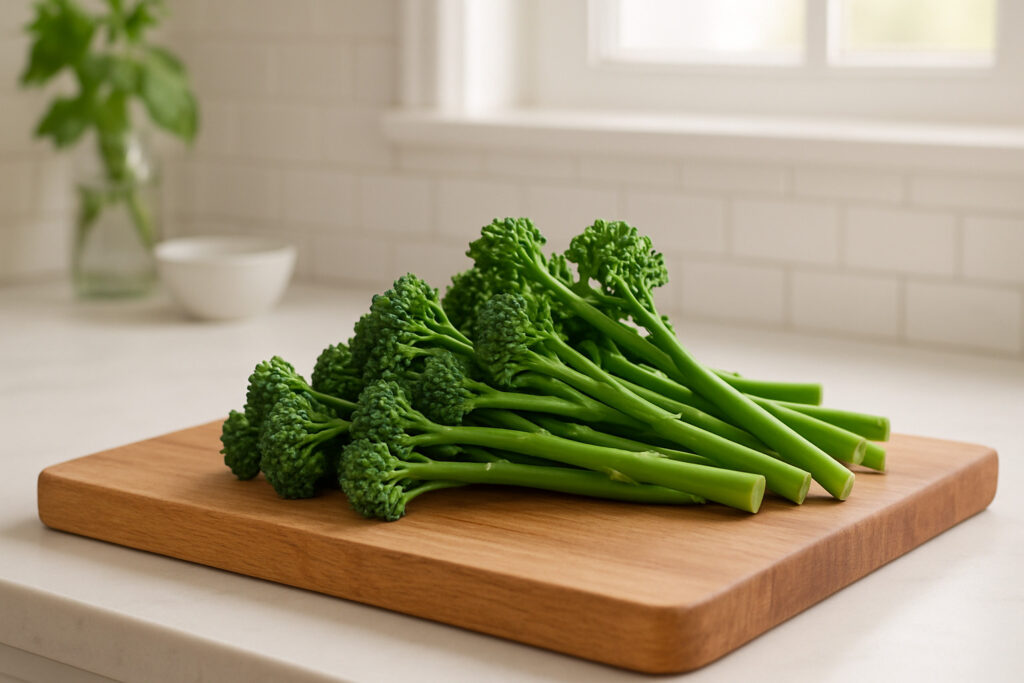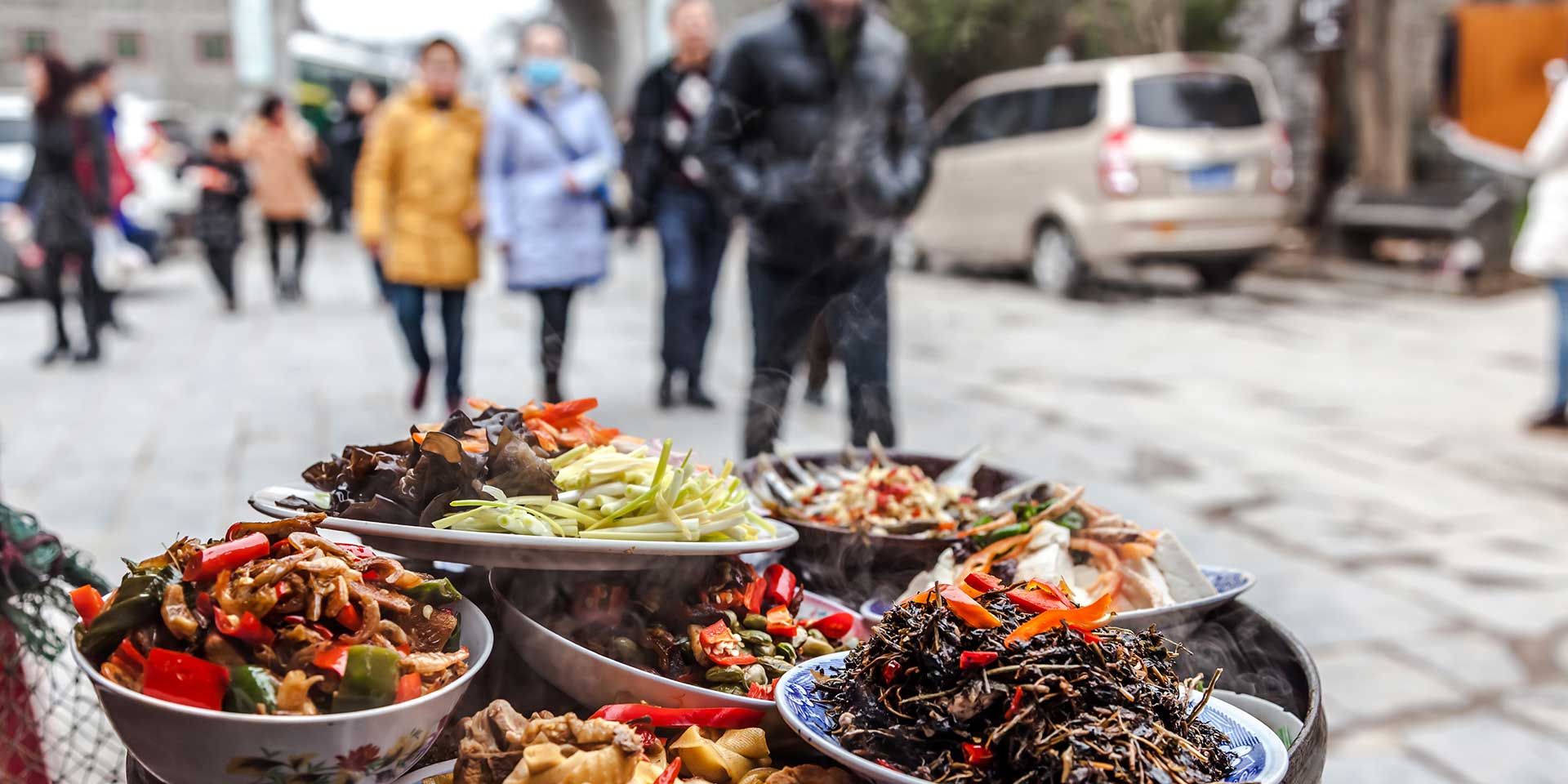Why Broccolini Is Taking Over Restaurant Menus Worldwide
Broccolini might look like baby broccoli, but this neat vegetable is actually a carefully crafted hybrid that’s winning over chefs and home cooks around the globe. If you’re wondering what makes this slender green standout, here’s what you need to know:
Quick Facts About Broccolini:
- What it is: A hybrid of broccoli and Chinese broccoli (gai lan), developed in Japan in 1993
- Taste: Milder and sweeter than regular broccoli with a slight peppery note
- Texture: Tender stems that don’t need peeling, plus delicate florets
- Cooking time: Faster than broccoli – just 3-7 minutes for most methods
- Nutrition: High in vitamins A, C, and K, plus cancer-fighting compounds like sulforaphane
As one food blogger perfectly captured it: “Every time I cook broccolini, I wonder why I don’t cook it more often. It’s basically broccoli’s tastier cousin.”
The name confusion is real – you’ll see it called “baby broccoli,” “tenderstem broccoli,” or “Chinese kale,” but true broccolini is that specific hybrid created by Japan’s Sakata Seed Company.
What makes broccolini special for today’s diners? It’s 100% edible from flower to stem, creating zero waste. The entire stalk cooks evenly, and those small yellow flowers you sometimes see? They’re completely normal and edible too.
For foodie travelers seeking authentic culinary experiences, broccolini represents the perfect blend of innovation and tradition – a vegetable that bridges Eastern and Western cuisines while delivering serious nutritional punch.
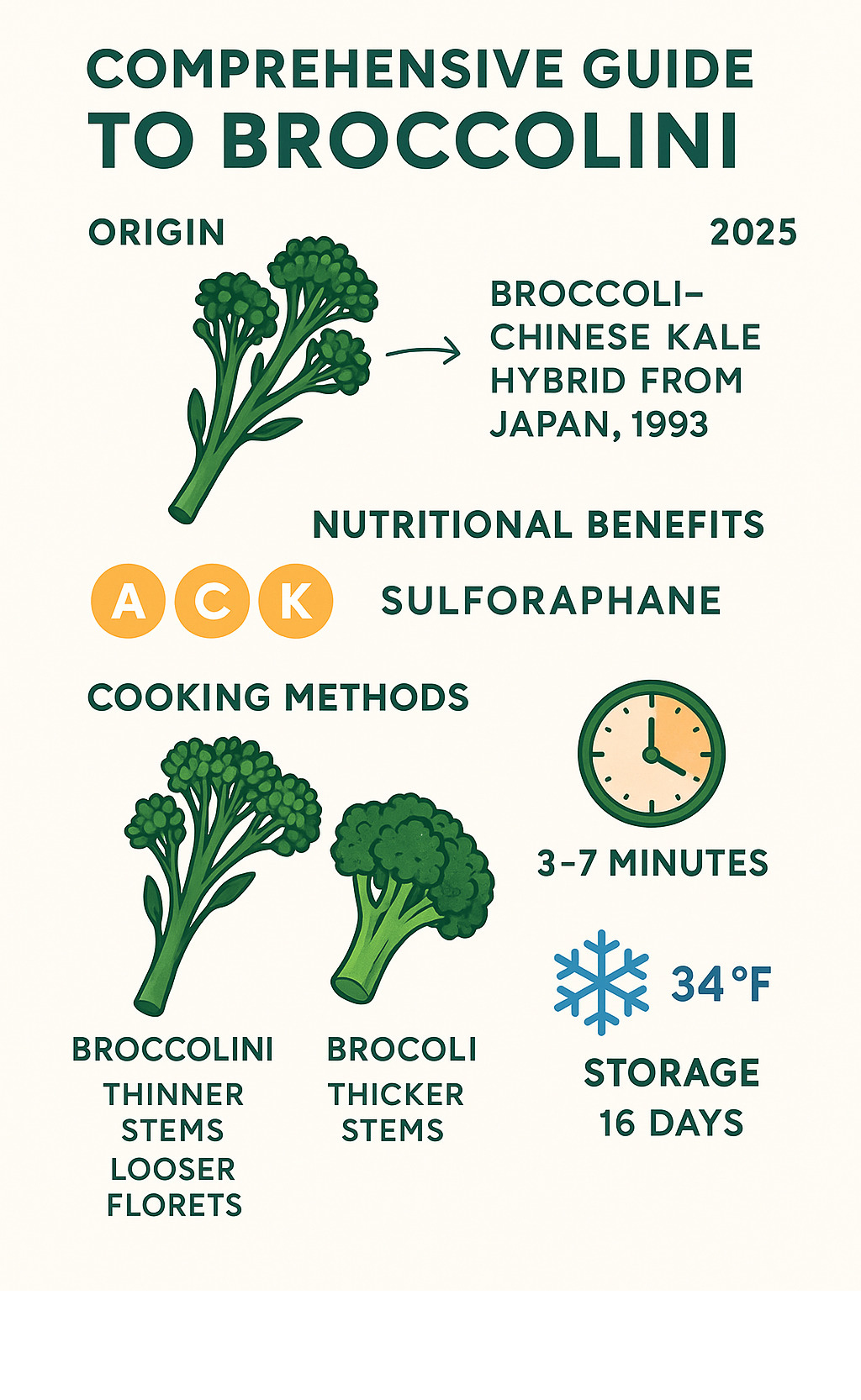
Similar topics to broccolini:
What Is Broccolini? History, Varieties & Key Differences
Broccolini wasn’t finded growing wild in some remote corner of the world. Instead, this neat vegetable was born from a specific mission: create something that combines the best qualities of broccoli and Chinese broccoli while thriving in warmer climates. It’s agricultural innovation at its finest, and honestly, we’re grateful someone had this brilliant idea.
This hybrid belongs to the Brassicaceae family, making it cousins with cabbage, Brussels sprouts, and kale. What sets broccolini apart is its graceful appearance – it grows up to 80 centimeters (31 inches) tall with those signature slender stems that stretch 15-30 centimeters long. The florets are smaller and looser than regular broccoli, giving it an almost delicate, refined look that makes any dish feel a bit more sophisticated.
How Broccolini Was Developed
The story begins in 1993 when Japan’s Sakata Seed Company successfully crossed broccoli with gai lan (Chinese broccoli). Their goal was creating a milder-flavored vegetable that could handle heat better than traditional broccoli – a pretty smart move considering how picky broccoli can be about temperature.
When broccolini first launched in the United States in 1996, it went by the name “Asparation” – a clever nod to its asparagus-like appearance. But let’s be honest, the name didn’t exactly roll off the tongue or spark much excitement at the grocery store.
By 1998, someone had the brilliant idea to rebrand it as “broccolini,” meaning “little broccoli” in Italian. This name change was pure marketing gold and proved much more appealing to American consumers who were just starting to accept more adventurous vegetables.
The timing couldn’t have been better. As we moved into the late 1990s and early 2000s, diners were becoming more curious about new flavors and seeking vegetables that offered both serious nutrition and culinary versatility. Broccolini quickly became one of the fastest-growing vegetables on restaurant menus worldwide.
Broccolini vs. Broccoli, Broccoli Rabe & Gai Lan
Understanding the differences between these similar-looking vegetables can save you from kitchen confusion and help you make smarter choices for your meals.
When comparing broccolini vs. broccoli, the differences are pretty remarkable. Broccolini offers a milder, sweeter flavor with much less of that sometimes overwhelming broccoli bitterness. The stems are naturally tender and don’t require peeling, unlike broccoli’s thick stems that can be tough and fibrous. Cooking time is where broccolini really shines – it’s ready in just 3-7 minutes compared to broccoli’s 8-12 minutes. Plus, farmers can harvest broccolini multiple times (3-5 harvests per growing cycle) while broccoli gives you just one shot.
Broccolini vs. broccoli rabe is where things get interesting. Despite looking similar, broccoli rabe is actually more closely related to turnips and packs a distinctly bitter, peppery punch that can dominate a dish. Broccolini gives you all the visual appeal without that intense bitterness that might overwhelm more delicate flavors.
Then there’s broccolini vs. gai lan (Chinese broccoli), which is actually one of broccolini’s parent vegetables. Gai lan has thicker stems, larger leaves, and a more pronounced bitter flavor profile. Broccolini inherited the best qualities from both parents – the tender stem quality from gai lan and the milder, more approachable flavor from regular broccoli.
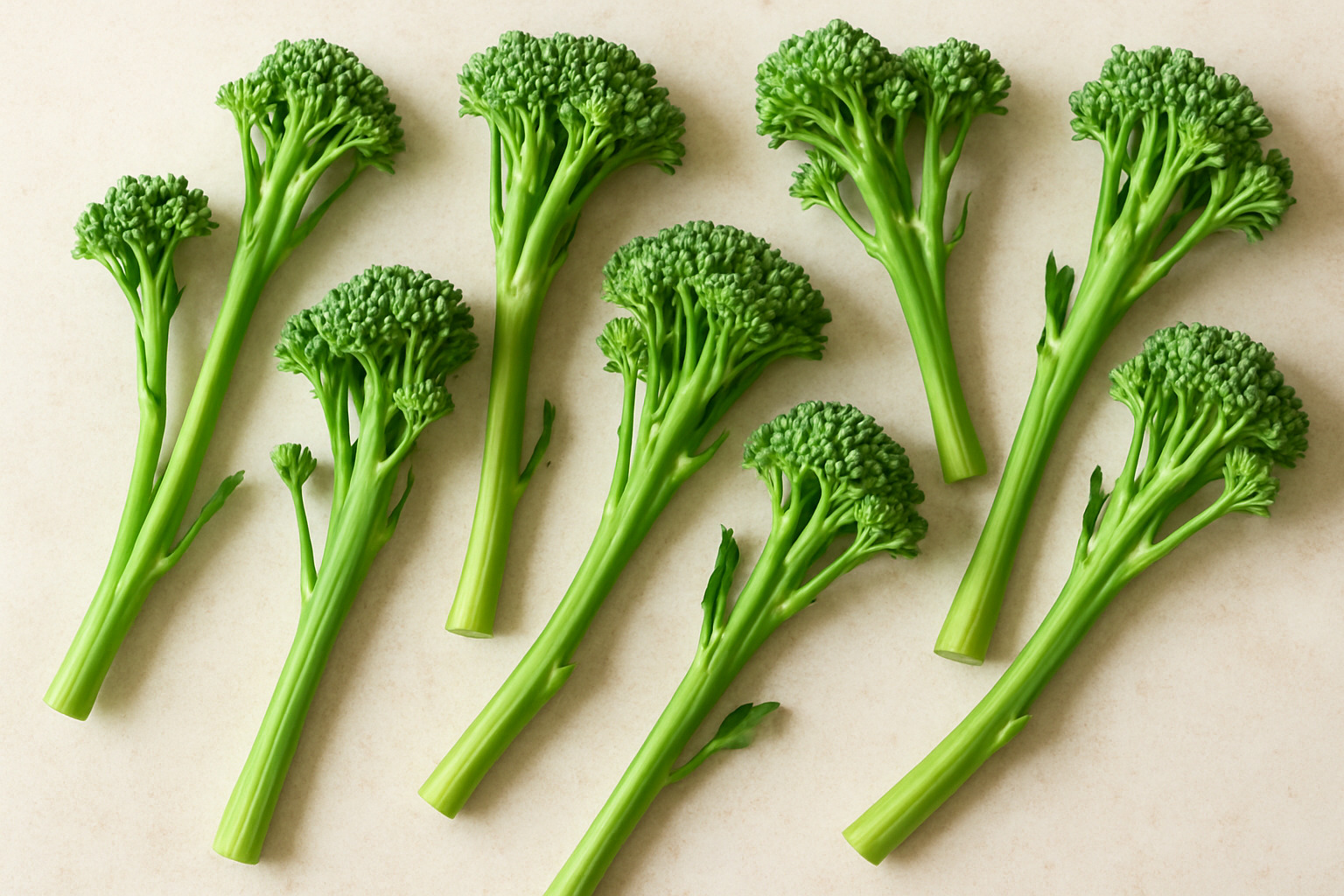
Nutritional Profile & Science-Backed Health Benefits of Broccolini
Here’s something that might surprise you: broccolini delivers more nutritional bang for your buck than many vegetables that take up twice as much space on your plate. At just 35 calories per 100-gram serving (about one cup), this slender green powerhouse proves that good things really do come in small packages.
What makes broccolini particularly impressive is its protein content – 3.5 grams per serving, which is comparable to white rice but with half the calories. You’re also getting 5 grams of fiber (that’s 21% of your daily needs), plus meaningful amounts of vitamins A, C, and K. The mineral lineup includes calcium, magnesium, potassium, and folate – all packed into those tender stems and delicate florets.
But here’s where broccolini gets really interesting from a health perspective. Like its cruciferous cousins, it contains glucosinolates – compounds that transform into powerful antioxidants when you chew or lightly cook the vegetable. Think of it as nature’s way of rewarding you for eating your greens.
Antioxidant & Anti-Inflammatory Compounds
The real star of broccolini’s nutritional show is sulforaphane. This compound forms when the enzyme myrosinase converts glucosinolates during chewing or minimal cooking. It’s like a little chemistry experiment happening right in your mouth – and the results are impressive.
Research suggests that sulforaphane acts as a powerful ally in your body’s natural defense systems. It helps neutralize toxins, reduce inflammation markers, and even protect DNA from mutations. The phenolic acids and flavonoids in broccolini add another layer of antioxidant protection, working together to combat the oxidative stress that contributes to aging and chronic disease.
What’s particularly exciting is that broccolini’s unique breeding may have actually improved the concentration of certain beneficial compounds compared to its parent vegetables. It’s like getting an upgraded version of nature’s medicine cabinet.
Heart, Blood-Sugar & Cancer Research Highlights
The scientific community has been paying serious attention to cruciferous vegetables like broccolini, and the results are encouraging. A comprehensive 17-year study following 88,184 middle-aged adults found that higher intake of cruciferous vegetables was linked to lower all-cause mortality rates. That’s the kind of longevity data that makes nutritionists sit up and take notice.
When it comes to blood sugar management, a 12-week clinical trial involving 97 adults with type 2 diabetes showed promising results. Participants who received sulforaphane extract experienced significantly lower fasting blood sugar levels and improved HbA1c markers. While this study used concentrated extract, it suggests that regular consumption of sulforaphane-rich foods like broccolini could be a tasty way to support healthy blood sugar levels.
The cancer research is equally intriguing. Laboratory studies have shown that compounds in broccolini may help inhibit the growth of certain cancer cells. The myrosinase enzyme produces antioxidant compounds that researchers have linked to protection against four types of cancer, though more human studies are needed to confirm these effects.
For heart health, broccolini offers a triple threat: fiber to help manage cholesterol levels, potassium to support healthy blood pressure, and antioxidants to protect against cardiovascular damage. It’s like having a tiny green cardiologist on your plate.
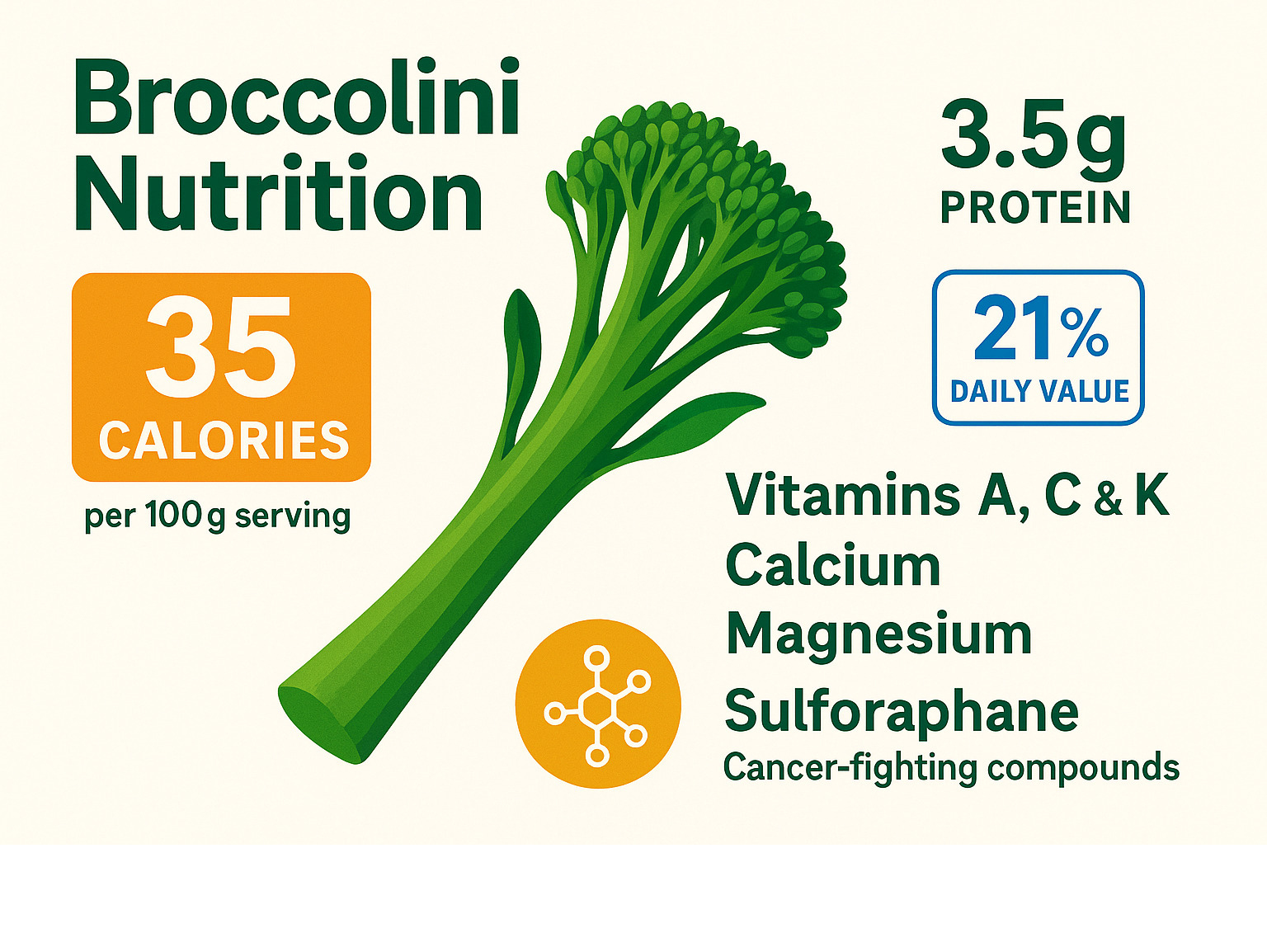
Buying, Selecting & Storing Broccolini for Maximum Freshness
Shopping for broccolini is pretty straightforward once you know what signals freshness. The key is understanding that this hybrid vegetable has its own personality – it’s not quite broccoli, so the usual broccoli rules don’t always apply.
When you’re at the grocery store, head straight to the produce section and look for PLU code 3277. You’ll often find it labeled as “baby broccoli,” which we know isn’t technically correct, but that’s how most stores market it. Don’t let the name confusion throw you off.
Fresh broccolini has stems that feel firm and look bright green without any yellowing. The florets should be tight and dark green – though here’s something interesting that surprises many shoppers: those small yellow flowers you sometimes see are completely normal and totally edible. In fact, they add a slightly sweet, delicate flavor that many chefs actually prefer.
Check the leaves too. They should look perky and fresh, not wilted or yellowing around the edges. If you’re planning to cook the stems and florets together (which we recommend), try to choose bunches where the stems are relatively uniform in thickness. This ensures everything cooks evenly.
Peak season varies depending on where your broccolini comes from. In the United States, it’s primarily grown in California during summer and Arizona during winter months, which means you can find quality broccolini year-round. This consistent availability makes it perfect for weekly meal planning.
For those interested in sustainable shopping, look for locally grown options when available. Since broccolini is a zero-waste crop – every part from stem to flower is edible – it’s already an environmentally conscious choice. You can learn more about making sustainable food decisions in our guide to locally sourced ingredients.
Once you get your broccolini home, proper storage makes all the difference. The magic number is 34°F – just above freezing. Your refrigerator’s vegetable crisper drawer is perfect for this. Store it in a perforated plastic bag or wrap it loosely in damp paper towels to maintain the right humidity level.
Here’s the good news: properly stored broccolini stays fresh for up to 16 days, which is longer than most people expect. The trick is not washing it until you’re ready to cook. That extra moisture can actually speed up deterioration, so resist the urge to prep it too far in advance.
The stems should maintain their firmness throughout the storage period, and the florets should stay tight and green. If you notice the stems getting soft or the florets starting to yellow, it’s time to use it up quickly – maybe in a quick sauté or added to a stir-fry.
Cooking Techniques & Inspiring Broccolini Recipes
The magic of broccolini happens in the kitchen, where its tender stems and delicate florets transform into something truly special with just a few minutes of cooking. Unlike its bulkier cousin broccoli, you can cook broccolini quickly without worrying about tough stems or uneven textures.
Getting started is beautifully simple. Just rinse your broccolini under cool water, trim about half an inch from the bottom of the stems, and you’re ready to go. There’s no peeling, no complicated prep work – just pure cooking pleasure.
The key to perfect broccolini is understanding that those slender stems cook at the same rate as the florets. This means you can use quick sauté methods, high-heat roasting, gentle steaming, outdoor grilling, or even the blanch-and-shock technique for meal prep. Every part of the vegetable is completely edible, making it a true zero-waste ingredient.
What really sets broccolini apart is how it pairs with bold flavors. Think garlic and red pepper flakes for heat, lemon and parmesan for brightness, or soy sauce and ginger for an Asian twist. The vegetable’s mild, slightly sweet flavor acts like a canvas for whatever flavor direction you want to explore.
Weeknight Speed: 10-Minute Garlic Broccolini
When you need something delicious on the table fast, this method never fails. Start by heating two tablespoons of olive oil in a large skillet until it shimmers – that’s your signal the pan is hot enough.
Add your trimmed broccolini with a good pinch of kosher salt and let it sauté for about two minutes, tossing occasionally. The stems should start to turn bright green and develop just a hint of caramelization.
Now comes the flavor magic: add three thinly sliced garlic cloves and a quarter teaspoon of red pepper flakes if you like a little heat. Cook for just 30 seconds until that garlic becomes fragrant – any longer and it might burn.
Here’s the secret step that makes restaurant-quality broccolini at home: add half a cup of water to the hot pan and immediately cover it. The steam that creates will finish cooking the stems perfectly while keeping them bright green. After just one to two minutes, remove the lid and finish with a squeeze of fresh lemon juice.
The result? Broccolini that’s tender but still has a satisfying bite, with stems that are as delicious as the florets.
Show-Stopper Dishes & Creative Uses
When you want to lift broccolini beyond a simple side dish, roasting at 425 degrees Fahrenheit creates something truly spectacular. Toss the spears with olive oil, sliced garlic, and thin lemon slices, then roast for 10 to 15 minutes until the tips get beautifully charred and the stems become fork-tender.
Broccolini makes an unexpected star as a pizza topping when lightly charred and paired with creamy ricotta, roasted garlic, and a drizzle of honey spiked with Calabrian chile oil. The contrast between the crispy crust and tender vegetables creates textural magic.
For pasta dishes, sautéed broccolini with cherry tomatoes transforms simple penne into something restaurant-worthy. The vegetable’s neat appearance lifts the entire dish while adding serious nutritional value.
Tempura broccolini showcases the vegetable’s delicate nature beautifully. The light, crispy batter highlights the natural sweetness while creating an interesting textural contrast that’s perfect for tapas-style dining.
Grain bowls become instantly more appealing with broccolini’s vibrant color and satisfying crunch. Whether you’re using quinoa, farro, or brown rice as your base, the vegetable adds both visual appeal and nutritional density.
For even more creative inspiration, the Cookbook WikibooksCookbook has a recipe/module on Broccolini with international preparations that showcase this versatile vegetable.
Chef Tips for Perfect Texture & Color
Professional kitchens have perfected the art of cooking broccolini, and their techniques are surprisingly simple to master at home. The 425-degree roasting temperature isn’t arbitrary – it’s the sweet spot where stems become perfectly tender while florets develop those appealing char marks that add smoky flavor.
For meal prep or cold preparations, the ice-bath blanching method preserves both color and nutrients. Blanch your broccolini in boiling water for exactly three minutes, then immediately plunge it into ice water. This stops the cooking process instantly and locks in that vibrant green color that makes dishes so visually appealing.
The sauté-then-steam finish technique used in professional kitchens creates the perfect balance of flavor and texture. Start by sautéing broccolini in hot oil for two to three minutes to develop caramelized flavors, then add a splash of water and cover the pan. This two-step process ensures even cooking while maximizing flavor development – exactly what makes restaurant vegetables taste so much better than home-cooked versions.
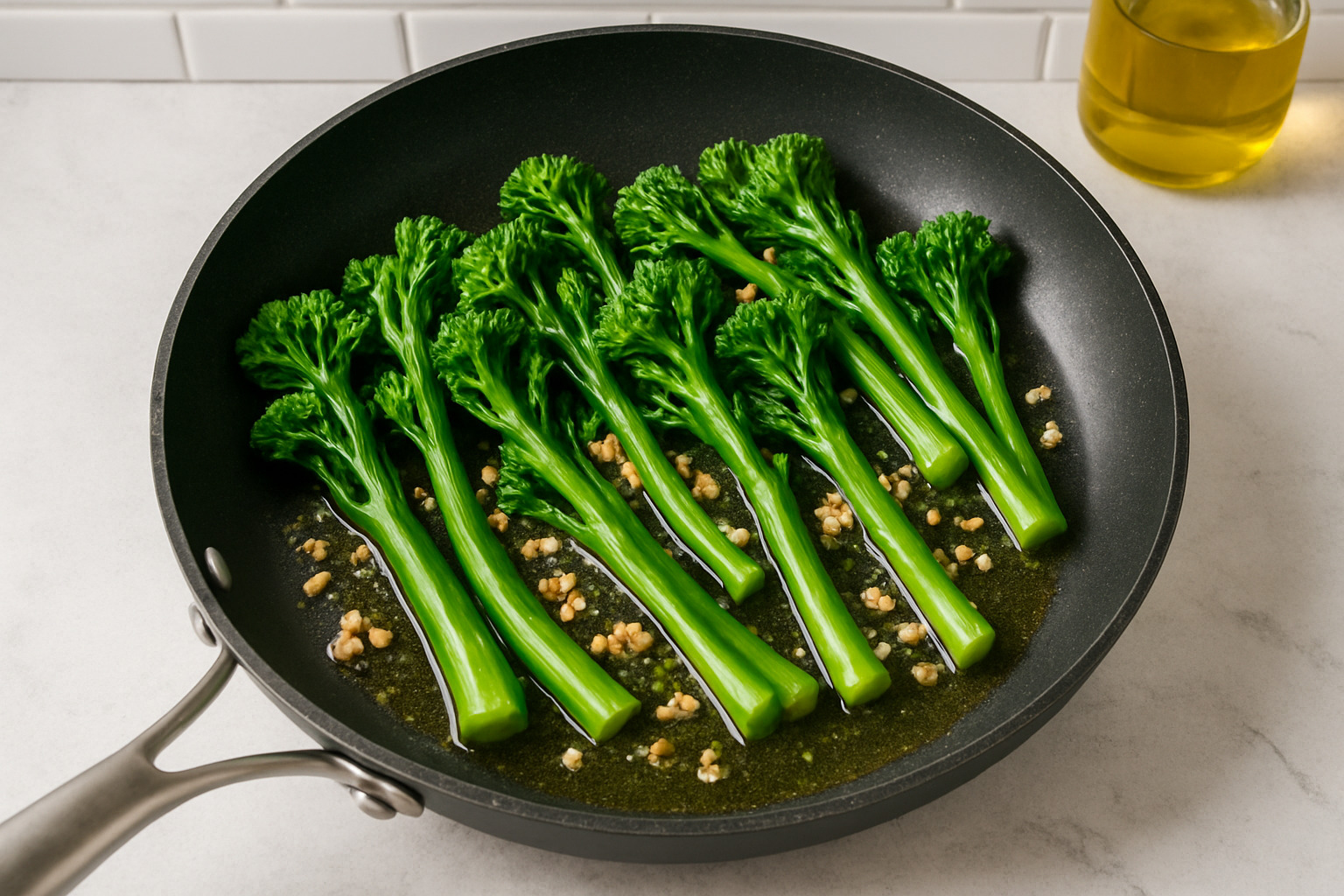
From Farm to Table: How Broccolini Is Grown & Its Sustainability Edge
Growing broccolini is like watching a well-choreographed dance between seasons, geography, and smart farming practices. This hybrid vegetable has revolutionized how we think about sustainable agriculture, and the story of how it gets from seed to your plate is pretty fascinating.
The Growing Journey:
From transplant to first harvest, broccolini needs about 50-60 days to mature – roughly the same timeline as regular broccoli. But here’s where things get interesting: while most vegetables give you one shot at harvest, broccolini keeps on giving.
The magic happens in the multi-harvest system. Farmers cut the main head when it’s perfectly developed but before those little yellow flowers appear. This doesn’t kill the plant – instead, it triggers something amazing. The plant responds by producing multiple side shoots over the following weeks, giving farmers 3-5 separate harvests from the same root system.
Think of it like pruning a rose bush. That initial cut encourages new growth, extending the productive life of each plant and maximizing what farmers can grow on the same piece of land.
Coast-to-Coast Production:
The year-round availability of broccolini isn’t an accident – it’s the result of strategic geographic planning. California fields handle summer production, taking advantage of the state’s Mediterranean climate and reliable irrigation systems. When temperatures drop, Arizona takes over during winter months, ensuring we never have to go without this versatile vegetable.
This coordinated approach means restaurants and home cooks can count on fresh broccolini regardless of season, supporting consistent menu planning and reducing the need for less sustainable imported alternatives.
Post-Harvest Precision:
The moment broccolini is harvested, the clock starts ticking. Farmers immediately cool it to 32°F (0°C) to preserve those tender florets and maintain nutritional quality. Combined with modified-atmosphere packaging, this rapid cooling process extends shelf life up to 16 days when properly stored.
This careful handling explains why broccolini maintains its crisp texture and vibrant color even after traveling from farm to your local market.
The Sustainability Story:
What makes broccolini a true environmental winner is its zero-waste nature. Every single part – from the tender stems to the delicate florets to those occasional yellow flowers – is completely edible and nutritious. Compare this to vegetables where you discard stems, outer leaves, or tough portions, and you’ll see why broccolini represents the future of sustainable eating.
The multi-harvest growing method amplifies these benefits. Instead of replanting after a single harvest, farmers continue harvesting from established plants, dramatically reducing water usage, labor inputs, and soil disruption per pound of food produced. It’s agricultural efficiency at its finest.
For forward-thinking restaurants and environmentally conscious home cooks, broccolini represents an ideal intersection of culinary excellence and environmental responsibility. The vegetable’s growing methods align perfectly with modern sustainable dining practices, making it a smart choice for anyone looking to reduce their environmental footprint without sacrificing flavor or nutrition.
Recent research into biofortification – enhancing the nutritional content of crops through selective breeding – suggests that broccolini varieties may become even more nutritionally dense in coming years, further cementing its position as a sustainability superstar in the produce world.
Frequently Asked Questions about Broccolini
Is broccolini genetically modified?
Here’s something that surprises many people: broccolini is absolutely not genetically modified. This is one of the most common misconceptions we hear from curious food lovers.
What actually happened is much more traditional and fascinating. Back in 1993, Japan’s Sakata Seed Company used conventional plant breeding techniques – the same methods farmers have used for centuries – to cross regular broccoli with Chinese broccoli (gai lan). Think of it like how different apple varieties are created by cross-pollinating existing trees.
No laboratory genetic manipulation was involved. Broccolini is simply the delicious result of careful, patient plant breeding that took advantage of natural compatibility between these two vegetables in the same plant family.
Can I eat broccolini raw?
You absolutely can, and it’s delightful! Broccolini is one of those vegetables that’s genuinely enjoyable raw, unlike some of its more bitter cousins in the cruciferous family.
The stems are naturally tender enough to eat without any cooking, making broccolini perfect for crudité platters alongside your favorite dips. You can also chop it raw into salads for a satisfying crunch and mild, sweet flavor that won’t overpower other ingredients.
Here’s a neat trick many chefs use: if you want to maximize the nutritional benefits while keeping that crisp texture, try a quick blanch. Dip the broccolini in boiling water for just a few seconds, then immediately plunge it into ice water. This brief heat exposure helps activate beneficial compounds like sulforaphane while maintaining that perfect crisp bite.
Why is broccolini pricier than broccoli?
We get this question a lot, and honestly, it’s a fair one when you’re comparing prices at the grocery store. Several factors work together to make broccolini more expensive than regular broccoli.
Production complexity plays a big role. As a hybrid vegetable, broccolini requires more specialized growing knowledge and careful handling throughout the growing process. Farmers need specific expertise that goes beyond traditional broccoli cultivation.
The harvest process is also more labor-intensive. While broccolini can be harvested multiple times from the same plant (which is great for sustainability), this means farm workers need to visit the fields more frequently for hand-harvesting rather than doing one big mechanical harvest.
Market demand has really taken off as restaurants and health-conscious home cooks find broccolini’s superior flavor and versatility. When demand outpaces supply, prices naturally rise.
Then there’s the careful handling required after harvest. Broccolini needs precise temperature control and specialized packaging to maintain that impressive 16-day shelf life, adding to distribution costs.
Finally, broccolini is still produced in smaller quantities compared to regular broccoli, so it doesn’t benefit from the same economies of scale that keep common vegetables affordable.
Many food enthusiasts find the price difference worthwhile when they consider broccolini’s superior taste, faster cooking time, and the fact that every single part is edible – no waste means better value per bite.
Conclusion
After exploring everything from its fascinating origin story to those crisp-tender stems that cook in minutes, it’s clear why broccolini has become such a beloved ingredient in kitchens worldwide. This isn’t just another vegetable trend – it’s a genuine culinary breakthrough that bridges the gap between health, flavor, and sustainability.
What makes broccolini truly special is how it solves so many common cooking challenges. No more struggling with tough broccoli stems or bitter greens that need extensive preparation. Instead, you get a vegetable that’s completely edible, cooks evenly in under 10 minutes, and brings a sophisticated sweetness to any dish.
The nutritional powerhouse aspect doesn’t hurt either. When you’re getting vitamins A, C, and K plus those cancer-fighting compounds like sulforaphane, you’re not just feeding your family – you’re nourishing them. And at just 35 calories per serving with 5 grams of fiber, broccolini proves that healthy eating doesn’t mean sacrificing satisfaction.
From a sustainability perspective, broccolini represents the future of conscious dining. Its zero-waste profile means every part of your purchase ends up on the plate, not in the compost bin. The multi-harvest growing method maximizes land use while reducing environmental impact – exactly the kind of agricultural innovation we need more of.
For food enthusiasts and travelers seeking authentic culinary experiences, broccolini offers something unique: a vegetable that’s both globally inspired and locally adaptable. Whether you’re recreating that perfect dish from your last restaurant trip or exploring new flavors at home, this hybrid delivers restaurant-quality results with home-cook simplicity.
As we continue finding the connections between great food, travel experiences, and sustainable choices here at The Dining Destination, broccolini stands out as a perfect example of how modern agriculture can improve both our plates and our planet. For more inspiration on making sustainable choices during your culinary trips, explore our guide to sustainable menu options.
The next time you’re planning a special dinner or simply want to lift your weeknight cooking, broccolini isn’t just an ingredient – it’s your ticket to better flavor, better nutrition, and better environmental choices all wrapped up in one beautiful green package.

